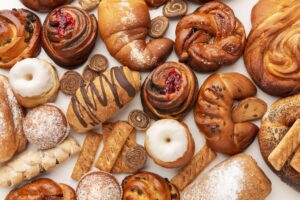When we think of sugar in baking, the first thing that comes to mind is sweetness. But this humble ingredient is a silent powerhouse, contributing far more than just flavor to your favorite treats. From creating tender cakes to ensuring golden-brown crusts, sugar’s functions are rooted in chemistry, texture, and even preservation. Understanding these roles can transform your baking from good to exceptional. In this deep dive, we’ll explore how sugar shapes the structure, appearance, and longevity of baked goods—proving it’s anything but a one-trick ingredient.
What Types of Sugar Are Essential for Baking?
Not all sugars are created equal. Granulated sugar, with its fine crystals, is a go-to for creaming with butter to create airy cake batters. Its neutral flavor allows other ingredients to shine while ensuring a light texture. Brown sugar, on the other hand, contains molasses, which adds moisture and a deeper flavor—ideal for chewy cookies like chocolate chip. Powdered sugar, finely ground and often mixed with cornstarch, dissolves quickly, making it perfect for frostings and delicate meringues.
Beyond these basics, alternatives like honey, maple syrup, and coconut sugar are gaining popularity. These natural sweeteners bring unique flavors and moisture profiles. For instance, honey’s high fructose content can accelerate browning, while coconut sugar’s coarse texture might require recipe adjustments. The type of sugar you choose can dramatically alter your final product, so experimentation is key.
How Does Sugar Enhance Flavor Beyond Sweetness?
While sugar’s primary role is as a sweetening agent, it also acts as a flavor enhancer. In bread, a small amount of sugar balances the tang of yeast, while in chocolate desserts, it tempers bitterness. Interestingly, sugar can amplify savory notes too—think of caramelized onions or soy-glazed meats. This balancing act makes it indispensable in both sweet and savory baking.
It also helps mask undesirable flavors. For example, whole-grain flours can have a slightly bitter edge, which sugar softens. Even a pinch in tomato-based sauces or herbed breads can round out sharpness without making the dish taste sugary. This duality underscores why simply reducing sugar in recipes can lead to unbalanced or underwhelming results.
Sugar’s Secret Role in Texture Development
Texture is where sugar truly flexes its muscles. When creamed with butter, sugar traps air pockets, leading to fluffy cakes and tender cookies. A 2025 study on shortbread found that higher sugar content increased browning and crispiness—proof that quantity matters. Brown sugar’s molasses content binds water, creating chewiness in cookies, while powdered sugar’s fine texture ensures smooth frostings without grittiness.
In breads, sugar feeds yeast, which produces carbon dioxide for rise. Without it, doughs may be dense. However, too much sugar can weaken gluten networks, causing collapse. This delicate balance explains why sugary pastries like brioche require careful kneading. Even in gluten-free baking, sugar contributes structure by stabilizing egg foams or binding with starches.
How Does Sugar Keep Baked Goods Fresh?
Sugar is hygroscopic, meaning it attracts and holds moisture. This property helps cakes stay moist for days and prevents cookies from turning into croutons. For example, brown sugar’s high molasses content makes it a champion of moisture retention—a 2024 study showed cookies made with brown sugar stayed softer than those with white sugar. This is why artisanal bakeries often use invert sugars like honey or glucose syrup in their shelf-stable products.
However, not all sugars excel here. Powdered sugar, despite its fineness, can draw moisture from the air, leading to clumping—hence the cornstarch additive. Understanding these differences helps in choosing the right sugar for recipes meant to last. A sprinkle of granulated sugar on scones, for instance, creates a crunchy top that resists sogginess.
The Science Behind Sugar’s Transformative Power
Two key chemical reactions rely on sugar: caramelization and the Maillard reaction. Caramelization occurs when sugar is heated beyond its melting point (~160°C/320°F), breaking down into complex compounds that create rich, buttery flavors—think crème brûlée’s crackling top. The Maillard reaction, which happens when sugars react with proteins at lower temperatures, is responsible for the golden crust on bread and the roasted notes in coffee.
These processes aren’t just about color; they add depth to flavors. For caramelization to occur, sugars must be present in sufficient quantities, which is why low-sugar recipes often lack that signature “baked” taste. Meanwhile, the Maillard reaction explains why adding a dash of sugar to pizza dough can yield a more flavorful crust.
What Happens When You Reduce or Replace Sugar?
Cutting sugar isn’t as simple as swapping it for stevia. Sugar contributes to structure, moisture, and browning, so substitutes require careful adjustments. Erythritol, a popular alternative, doesn’t caramelize, leading to paler cookies. Applesauce or mashed bananas add moisture but can make baked goods gummy if not balanced with dry ingredients.
Reducing sugar also impacts gluten development. In cakes, less sugar means more gluten forms, resulting in a tougher crumb. To counter this, bakers might increase fat or use cake flour. For those seeking healthier options, combining alternatives—like dates for sweetness and a touch of honey for browning—can mimic sugar’s multifaceted role.
Mastering Sugar in Your Baking Journey
Sugar’s role in baking is as complex as it is crucial. It’s a tenderizer, preservative, flavor enhancer, and colorant all in one. Whether you’re crafting a flaky croissant or a fudgy brownie, understanding how sugar interacts with other ingredients empowers you to tweak recipes confidently. Ready to put this knowledge to the test? Experiment with different sugars in your next batch of cookies—swap white for brown, or try coconut sugar in a spice cake. The results might just surprise you.



